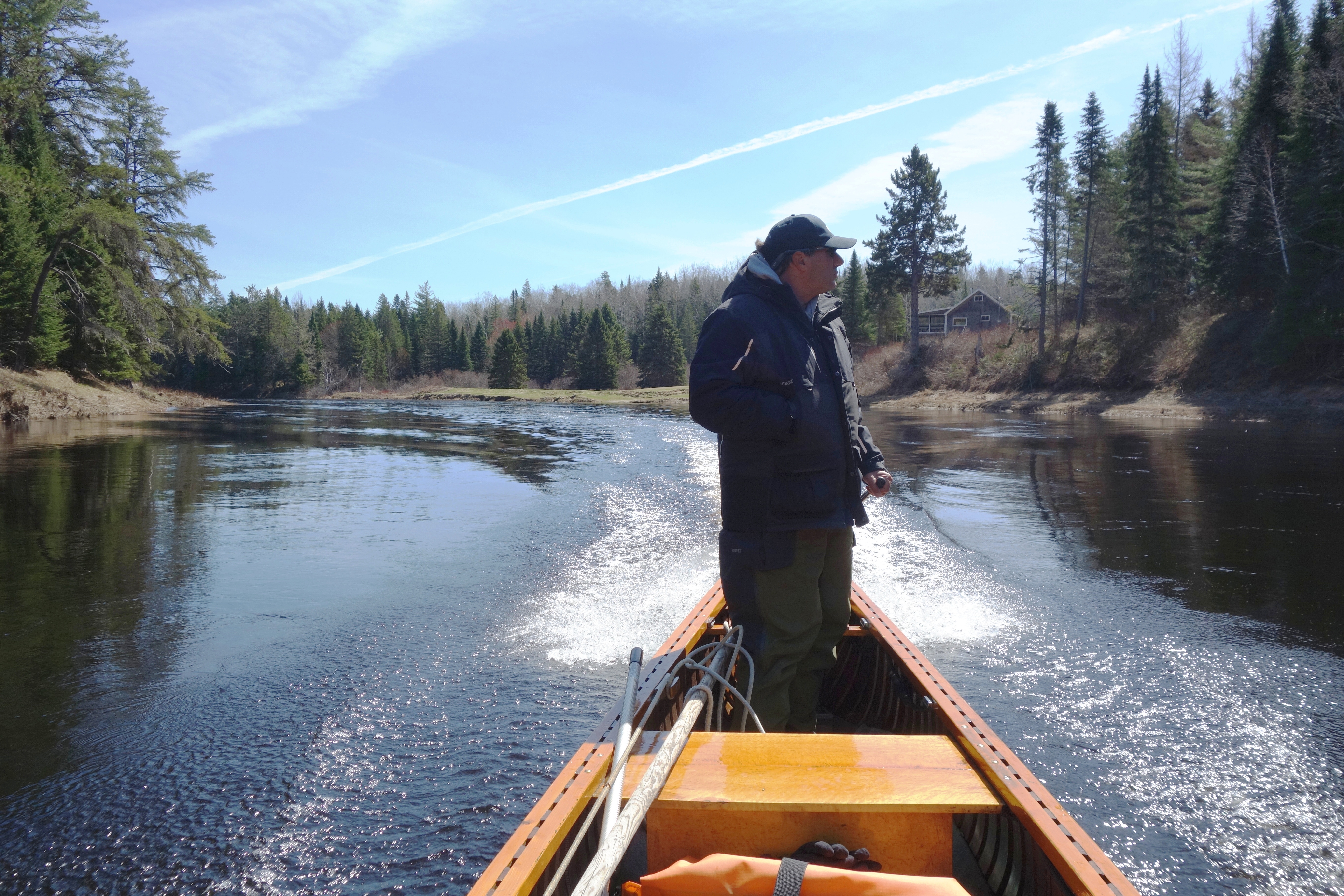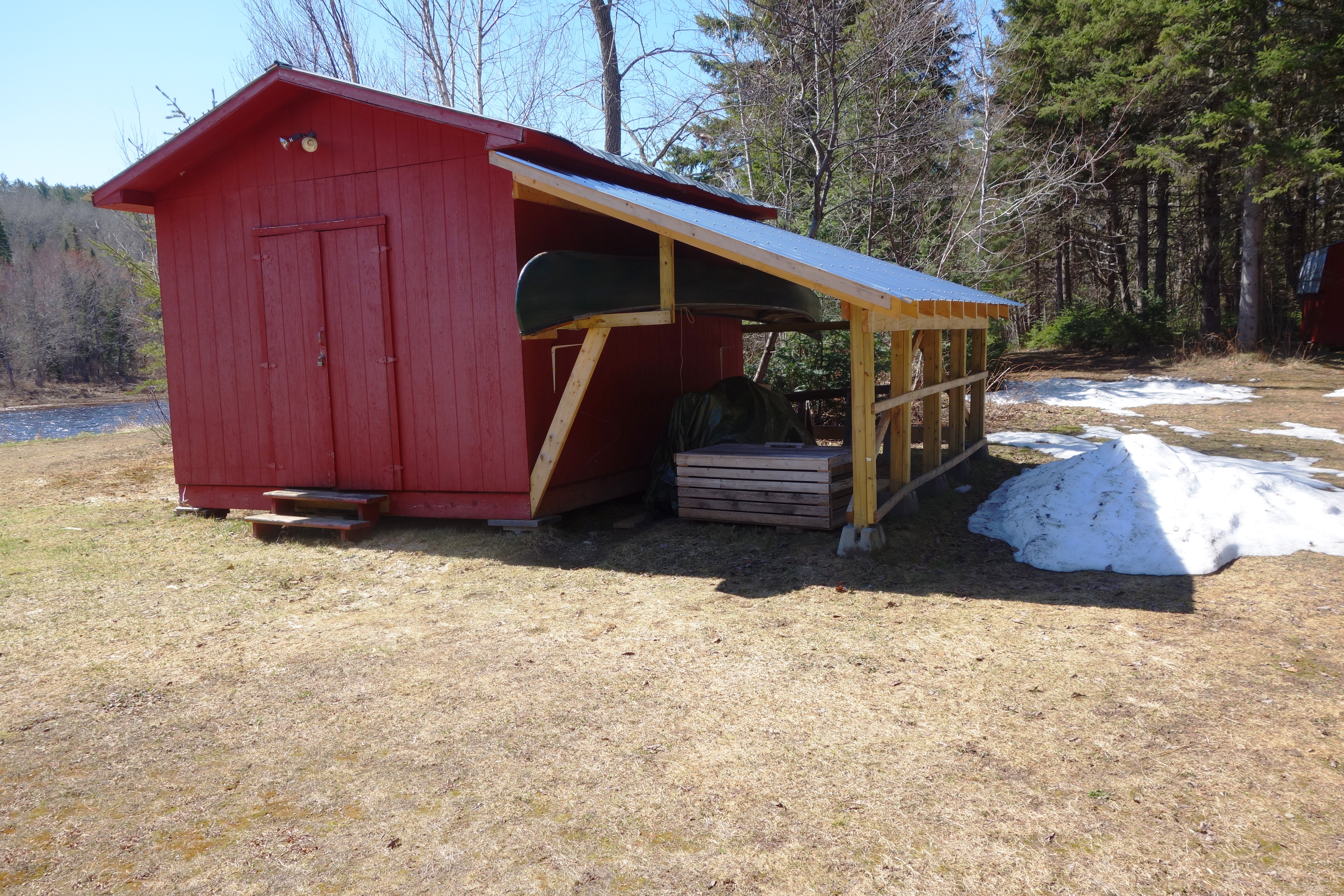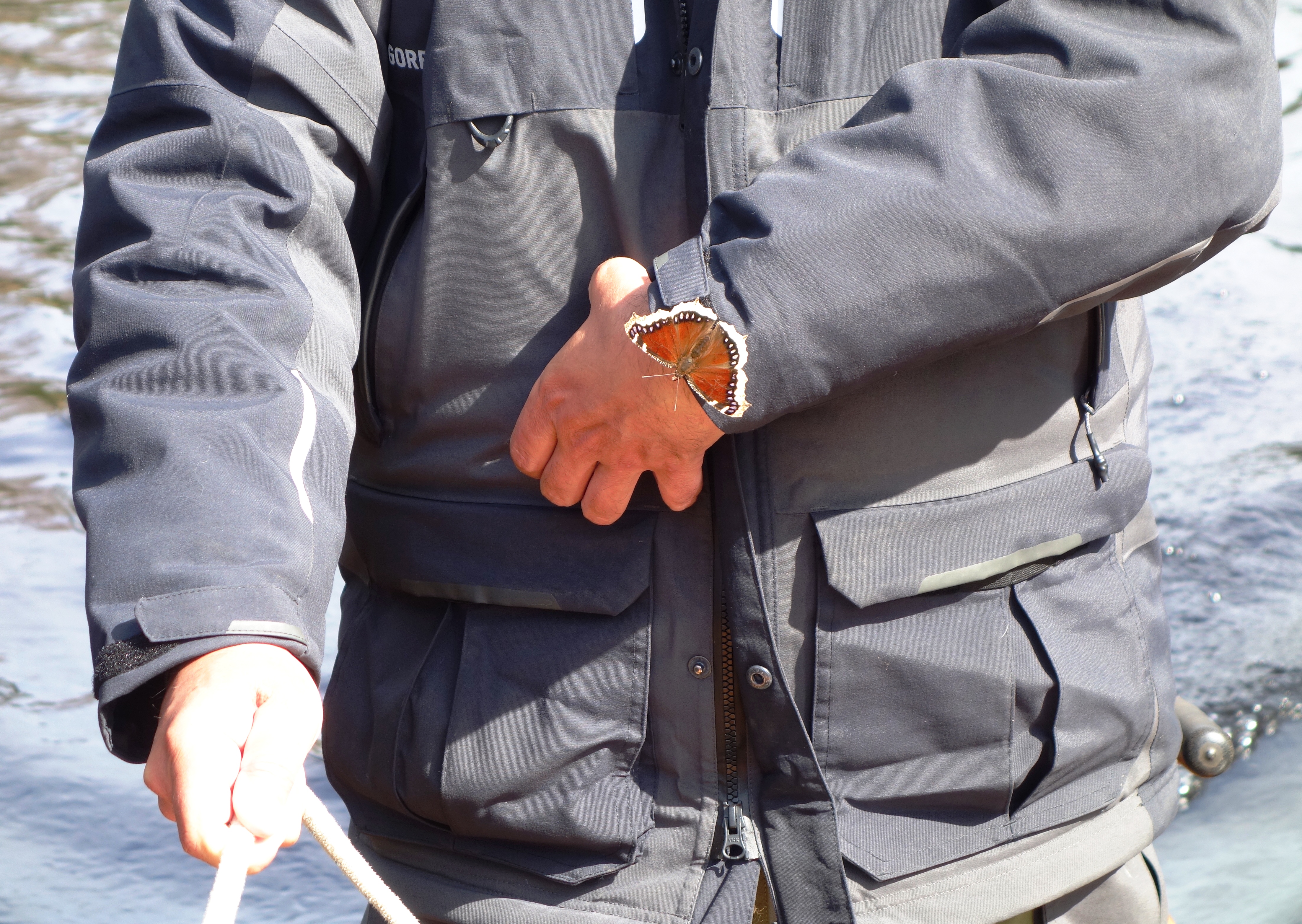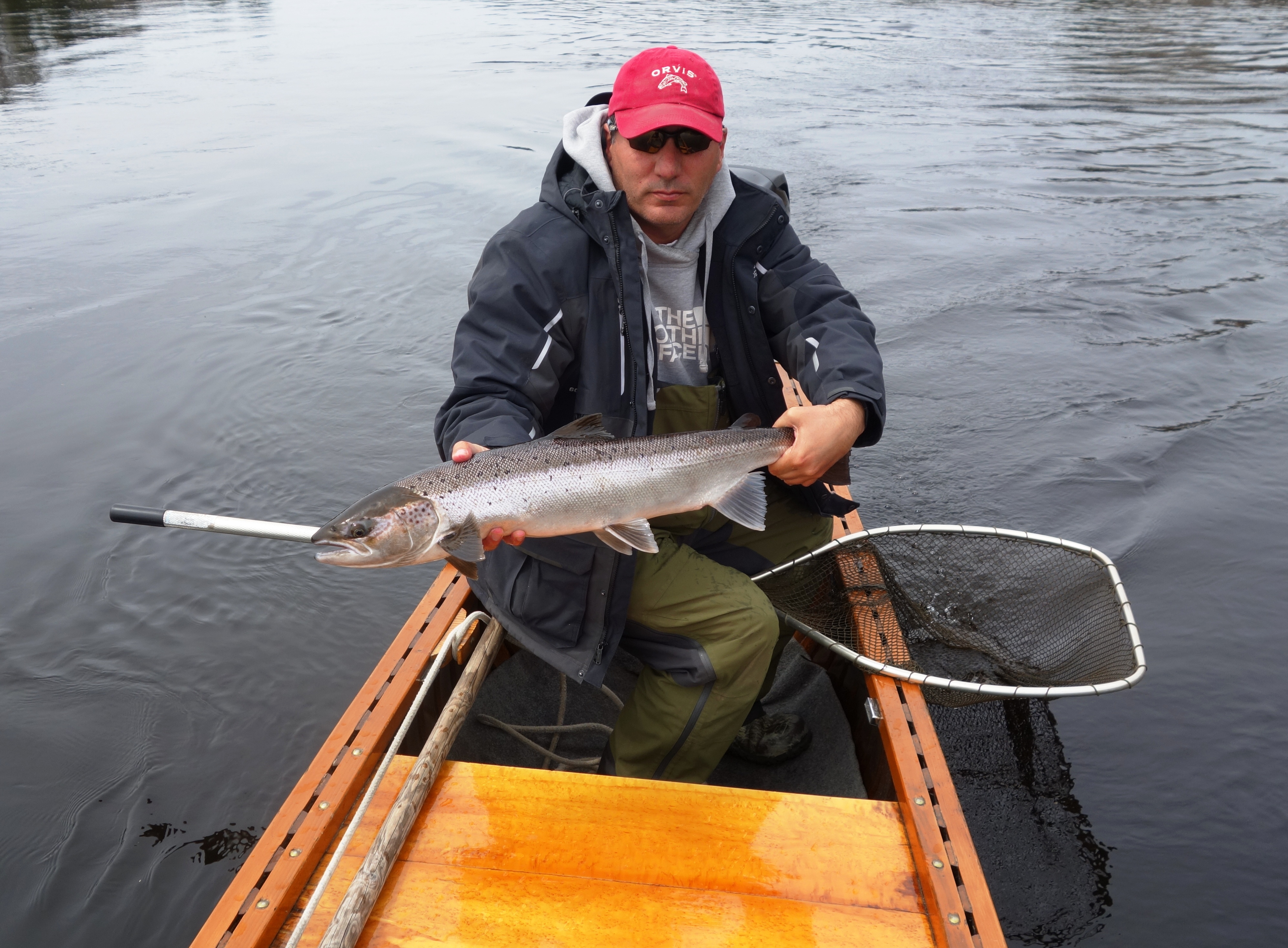
Early May 2017 The Miramichi Spring Advances – Slowly
Fishing Friends – I drove back on Saturday morning 5/6 to escape the heavy rain forecast for New Brunswick, including the Miramichi valley. The river was at quite a high level for this time of the year already, and I see this morning that we got 50 to 80mm of rain – 2 to 3 inches – over the Miramichi watershed. The river is at 5.1 meters at Blackville – the highest level of the season to date – and the graph is going straight up. It probably won’t crest in the down river areas until late Sunday night or Monday morning. We didn’t get the 100+mm that some forecasts predicted for certain areas, and with the river iced out and most of the snow out of the woods I hope that we will see no more than some very high water and perhaps flooding of some low lying areas. As guide Darrell Warren likes to say, “Hard to say not knowing.”
I was only able to get up for a couple of days of fishing on this trip, but as usual it was a great time. There is no such thing for me as a boring day on the Miramichi or the Cains. One of the express goals was for Jason Curtis and me to run a Sharpe canoe 21 miles up the Cains from where it enters the Miramichi to my camp at Mahoney Brook. I love everything about this trip, and one of the best things is the chance to again see all the great camps spread along the way. These are not huge, architecturally elaborate lodges as in the Restigouche style, but they are very appealing in their own right, and in keeping with the quiet, unpretentious beauty of the Cains. All these camps are pictured in earlier blog posts. Black Brook’s Admiral Pool camp is the first one, not even a mile up the river, then come the camps at Ted Williams old Teedlan Pool, Brophy Pool, Campbell’s, the Popples, Camp Stanton/Valentines – where the Sabbies River enters – Millet Underhill’s at Pigeon Ledge, a number of private camps in Shinnicksburn, Moore’s Pool, Doctor’s Island, Muzzerol Brook, Vaughn and Kevin Anthony’s, Six Mile Brook, and finally Mahoney Brook. After Mahoney Brook it is many miles upriver before you see another structure – I personally haven’t been quite that far.
Jason and I surveyed the camp and road in to see if we had suffered any winter damage, but everything was essentially as we had left it last fall. We grilled up Jason’s specialty of hot dogs slathered up with barbecue sauce, admired the view, downed a beer and went back out to fish the home pool for brook trout. As expected we found a few at the lower end of the run where the current begins to slow up to a comfortable pace. Casting our trout confidence fly, the Black Ghost, I got a nice strike that had me believing that I was on to a 3 or 4 pound brookie. It got off not too far from the net, but looking down into the tannic Cains we never caught a glimpse to identify it. After a couple more short strikes that also were solid enough to make me think that a substantial fish had hit the fly, I finally hooked up again, and this time Jason netted a very well-mended and remarkably silvery grilse kelt! These are fairly rare 20 miles up the Cains, and in fact Jason in his life-long fishing of the river had not gotten one that far up. The fish was in terrific condition.
A half hour later we had dropped down to where Six Mile Brook enters, and were picking away at some brook trout in the seam between the brook and the river when Keith Wilson and his friend John Robinson appeared in one of Wilson’s jet canoes. They had come down from launching at the Doaktown Road and were going to spend the night at a friend’s camp further down the river. Later Keith got a salmon kelt at a pool in Shinnickburn. He saw the fish roll at the tail of the pool and cast to it. Good stuff for spring salmon fishing where the norm is scraping the bottom with heavy sinking lines! We saw quite a few fish roll and jump at places along both the Cains and the Miramichi shore lines. This, Willy Bacso told me when I first started fishing the river, is what the kelts do as they are beginning in earnest to move out of the river. If they are leaving now they should certainly have some camouflage from the seals in the form of the big brown river that we will undoubtedly have by tomorrow as a result of all this rain.
When I was in camp two weeks ago the bird life was relatively limited, and wildlife was still in post-winter survival mode. We had a number of hungry deer out in the fields at all hours of the day. Now we are back to a smaller number of animals. I watched two of them with binoculars walk out and lay down in the field just as the evening turned to darkness.
There definitely were new summer arrivals, and on this trip we saw a pair of turkey vultures, several eagles, and a pair of sharp shinned hawks soaring around over us on the Cains. There seem to be numerous king fishers around this spring, and the dozen and a half swallow boxes set around Campbell’s fields were buzzing with tree swallows from dawn to dusk. In addition to a yearling moose up near Mahoney Brook and a bear near Underhill’s, we even saw the first large butterfly of the year which landed on Jason’s hand for a rest. I looked for but didn’t see bluebirds back at Campbell’s, and it is still a bit early for the humming birds, but they will be there in force before my next trip in early June. I hate waiting that long, and would like to make a late May trip to try for a very early salmon and sea run brookies, but I’m headed to the Varzuga on May 24, so the sea run brookies will have to wait until next year.
A hallmark of this spring’s kelt fishing has been how very good it is upriver from us, but comparatively slow it was on the lower river – still some good days, but not up to normal standards. Keith Wilson said that a sport who has been coming to his family’s place for 40 years remarked that it was the best spring fishing that he had ever experienced. Apparently he limited out every day of his trip.
Some speculation goes that in the constantly high water that the Miramichi has had this spring that the upper river has been clean and friendly whereas the lower river has had a lot of dirty water to contend with. On Friday I did most of my fishing on the river right around Campbell’s. Willy Bacso used to say that this big bend in the Miramichi was called The Golden Horse Shoe because it was such a gathering point for spring salmon. I worked the old familiar shore line both up and down river from the camp and had a decent afternoon Friday with a number of large silvery salmon and a fair amount of additional strikes that didn’t take quite aggressively enough for a lasting hook up.








Love to read your blog entries, Brad.
Thanks Bill, great to hear from you. You’ll be able to drive into Souderhunk before too long if it ever stops raining.
Nice report Brad. Enjoyed it very much.
My two Irish friends have just left my house heading home after a hard week on the Thurso, one of them had six and the other just the one, Sam came down with a virus and only fished for a couple of days. They were frequent visitors to Russia and they tell me the flies you were using on the Naver are the ones you require for your trip, I have loads in my box unused which are surplus to my requirements so if you wish I will send them to you.
Another two anglers last week on the Thurso had nine, all fish were caught on my Puppy Dog
Pat
Pat – thanks to all of your several previous generosities I have more than enough of your flies for the Varzuga. Besides that I hear those fish actually prefer the bloody “green machine”.
Bloody Green Machine. Rubbish.
Hi Brad. I enjoyed reading the post and in particular seeing the beautiful river. It it s cracker. As you know we don’t fish for kelts in Europe. It seems to me though because you fish for them perhaps you value them more highly, and perhaps this knocks on to them being a genuine part of the salmon protection and conservation effort? In Europe I fear they are treated rather poorly, the forgotten cousin yet they are of course a critical part of the ‘process’.
The Green machine is great on Varzuga, but only when the water is warm and low. I don’t know if you’ve heard, but this past winter has given them the deepest snow depth on record and so far it is staying cold up there. Certainly for the next week it is only going above zero degrees a few hours on a couple of days. This augers well for the fishing. A slow melt with large water reserves. Unless you’re going later in their season, ie after 15 June you could be leaving the Green Machines in your fly boxes and reaching for flies with rich tones of red, green and orange. Maybe I’ll see you in Murmansk or on the bank (I fly out 15 June, back on the 1 July)?
Paul – I’ll be in Russia almost three weeks earlier than that.
The folks I speak with in Scotland tell me that so few of the kelts live to return that they don’t think much about them. I’ve not seen a lot of research on that, especially on the northern rivers that I fish, but I see a lot of well-mended kelts and I suspect that many of them must survive to spawn again. I caught one a couple of years ago in the Naver that had been tagged there as a bright grilse a year and a half earlier. It had doubled in size.
You seem optimistic that the habitat is showing signs of thriving.
Phil – Atlantic salmon are up against it, but it is not the fault of the Miramichi. As you know from your time in politics a lot of people give lip service to conservation, but the reality in the Atlantic ocean is a lot different. For one thing Greenland is hammering our salmon with nets, and so far no one has had the guts to stand up to them. All things considered, though, fishing on the Miramichi can still be very good.
Dave Ledlie wrote in that his wife Pat identified the butterfly as a Mourning Cloak… Here is a web address to information on the species http://www.butterfliesandmoths.org/species/Nymphalis-antiopa. They go all the way to the tundra and are found all over the world, so having one show up on the Cains in May is probably not unheard of. It sure was beautiful.
Brad,
Thanks for the update. As always, very enjoyable. I look forward to reading about your trip to the Varzuga. Enjoy!
FYI … The Mourning cloak is one of the very few species of butterflies that overwinter as adults in New Brunswick. As such, they often are seen very early in the spring.
A beautiful insect and a sure sign that spring is here.
Jim
Great reading about your trip up the river. My trip wasn’t as successful the weekend before, but I’ll get even this summer!